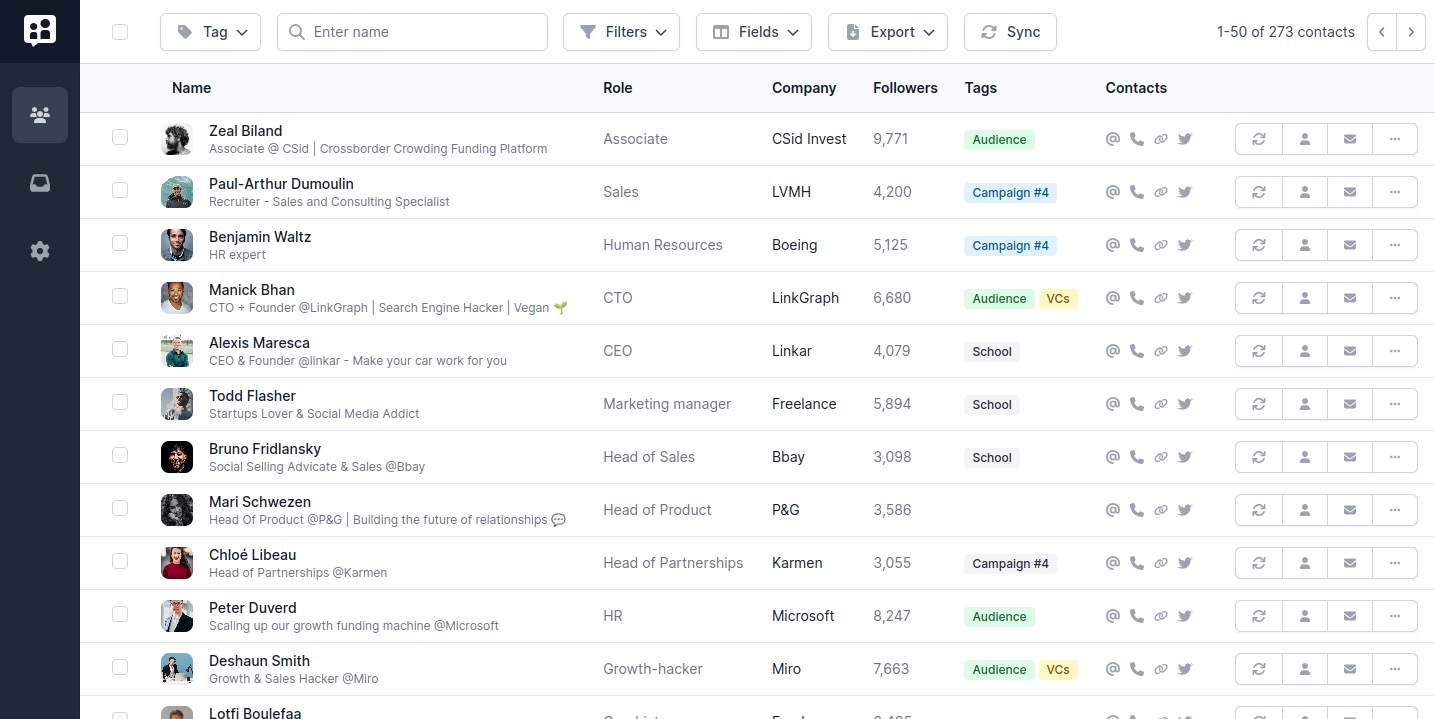How to Export LinkedIn Contacts: LinkedIn export vs Poked export
In this new era of networking, LinkedIn has become an invaluable tool for building professional connections. Often, we need to export LinkedIn contacts to consolidate and utilize this data effectively:
- Excel. Keep a .CSV file for yourself to use in Excel or Google Spreadsheets.
- CRM. To feed to your CRM and have fresh contacts informations.
- Automation. Or organize an automation campaign and send messages to 100s of connections.
The process of exporting your linkedin connections seem straightforward on the surface, but LinkedIn feature is quite disappointing as it gives you limited info and no emails…
Let’s see how you export your LinkedIn contacts the LinkedIn way vs the Poked way!

The Old Way: Export LinkedIn Contacts with LinkedIn native feature
LinkedIn does offer a built-in feature to export your connections. The process is quite simple. To get it, you can either go directly to LinkedIn Download-my-Data section, or follow this tutorial:
- Click the 'Me' icon located on the top right corner.
- In the drop-down, select 'Settings & Privacy'.
- In 'Settings & Privacy', navigate to the 'Data privacy' section.
- In this section, click on the 'Get a copy of your data' option.
- Specify what data you want to download. In our case: 'Connections'.
- Click 'Request Archive'.
- After requesting, you will need to wait a while. The wait time largely depends on the size of your network. LinkedIn will send an email to your registered email address with a link to download your connections.

Available information in the basic LinkedIn export file
The downloaded .CSV file will contain your LinkedIn contacts’ data. However, the information you get is rather basic:
- First Name & Last Name
- Company & Position
- Connection dates
- Email addresses (only if they're public)
The depth of data LinkedIn provides is quite limited, with only a handful of data points available.
Why we need a better LinkedIn contacts export…
With the standard LinkedIn export process, you're limited in the depth and granularity of the data you can extract. Here's why we need a better way to export LinkedIn contacts:
- Missing Email Addresses: LinkedIn exports public emails of opt-in users only. That’s 3% of LinkedIn users… What if we want more informations (phone, website, Twitter)?
- Limited Information: The standard LinkedIn export provides very basic information like names, headlines, and connection dates. For more in-depth analysis and use, this data isn't enough.
- No data Filtering: LinkedIn provides no filtering option, which means you can't selectively export data for a specific group of contacts. You either export all your connections or none.
- Few file formats available: LinkedIn offers no customization features when exporting contacts. If you need to manipulate the data in a specific way or format, you'll have to do it manually post-export.
- No automatic export. Exporting is a manual process, and LinkedIn doesn’t let you schedule or automate it.
Let’s find a better way.
Export your LinkedIn contacts with Poked
Poked offers a more advanced and efficient solution to exporting LinkedIn connections, while maintaining a user-friendly and simple process. This advanced approach doesn't necessarily mean it's more complex – it's just a few clicks and you're done! You'll then have all the data you need to organize your outreach, analyze your network, and more.

Here's a step-by-step guide:
- Create a Poked Account. The 14-day trial is sufficient for you to have you export all your contacts.
- Sync the LinkedIn contacts you're interested in. You can either manually select each profile or wait for all of them to be synced.
- Choose all the contacts you want to export. You can either select all or use checkboxes to select specific ones.
- Click on the 'Export' button in the CRM view.
- You'll then be prompted to select the desired export format. You can choose between CSV (which can be imported to Excel or Google Sheets) or JSON format.
And that's it! You now have a detailed, usable export of your LinkedIn contacts.
Available information with this export
The exported data will include a wide range of information like
- Name
- Headline
- About
- Contact informations (Email, phone number, website, Twitter)
- Current and past jobs details,
- Full educational background
- Skills
- Languages
- And more
If you want to work with that data even more precisely, Poked also comes with a .JSON export of your connections.
How to export LinkedIn contacts to Google Sheet
Now that you have your LinkedIn contacts exported via Poked, it's time to import this data into Google Sheets. This will allow you to sort, filter, and manipulate your contact data with the powerful tools Google Sheets provides. To do so:
- Open Google Sheets: Log into your Google account and open a new Google Sheets document.
- File > Import: Navigate to the 'File' menu and select 'Import'. This will open a new dialog box. Select the Poked export of your connections in .CSV format.
- Select import options: In the 'Import file' dialog box that appears, choose 'Create new spreadsheet', 'Insert new sheets', or 'Replace spreadsheet', depending on your needs. Ensure the 'Detect automatically' option is selected for separator type to ensure data is correctly divided into columns.
- Click 'Import': Finally, click 'Import' and wait for the data to populate your Google Sheets document.
And voila! Your LinkedIn contacts are now in a flexible and powerful spreadsheet format. You can add filters, share the sheet with your colleagues, or conduct further analysis based on the data.

Conclusion
Navigating the world of professional networking on LinkedIn can be complex, but exporting your LinkedIn contacts shouldn't be. With Poked, you have a robust tool at your disposal that not only makes exporting your contacts more efficient but also more insightful. Poked brings data accessibility and control into your hands, letting you explore the depths of your LinkedIn contacts beyond what LinkedIn itself offers.
Remember, the power of networking lies in the ability to manage and understand your connections. Poked helps you unlock that potential, delivering a much richer and more streamlined experience than the traditional LinkedIn export. Start using Poked today and discover the difference it can make to your professional networking journey. Happy exporting!
Frequently Asked Questions
Why don't I see the email of a connection in the exported data?
Poked exports only the data that LinkedIn users have made available on their profiles. If a user has chosen not to display their email, Poked cannot extract it.
Why is the synchronization taking time?
Poked works on your behalf to browse LinkedIn, and LinkedIn imposes restrictions on the number of profiles that can be browsed within 24 hours. However, if you're a Sales Navigator user, you can sync up to 200 profiles per day.
Does Poked comply with data privacy regulations like GDPR?
Yes, Poked is fully GDPR compliant. The exported content includes only the information that other LinkedIn users have willingly shared with you.
Can I choose the format of the exported data?
Yes, Poked allows you to export the data in two formats: CSV and JSON.
Can I import the exported data into Google Sheets?
Absolutely! We've provided a step-by-step guide above on how to import your Poked exported data into Google Sheets.
Remember, if you have more questions or need help, our support team is always ready to assist you. Stay tuned for more updates and improvements on our public roadmap at pokedhq.com/roadmap. Happy networking!

